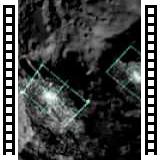The LCROSS mission is a search for water on the moon. The LCROSS mission is going to do this by sending a rocket crashing into the moon causing a big impact and creating a crater, throwing tons of debris and potentially water ice and vapor above the lunar surface. This impact will release materials from the lunar surface that will be analyzed for the presence of hydrated minerals which would tell researchers if water is there or not. The two main components of the LCROSS mission are the Shepherding Spacecraft (SS/C) and the Centaur upper stage rocket. The Shepherding Spacecraft guides the rocket to a site selected on the moon that has a high probability of containing water. Because they have only one chance with this mission in finding water, the researchers have to be very precise where they program the Shepherding Spacecraft to guide the rocket. The Shepherding Spacecraft and Centaur rocket were launched together with another spacecraft called the Lunar Reconnaissance Orbiter (LRO) on June 18, 2009. All three were connected to each other for launch, but then the LRO separated one hour after launch. The Shepherding Spacecraft guided the Centaur rocket through multiple Earth orbits, each taking about 38 days. The rocket then separated from the Shepherding Spacecraft and will impact the Moon on October 9, 2009 at more than twice the speed of a bullet, causing an impact that results in a big plume or cloud of lunar debris, and possibly water. While this is happening the ...















